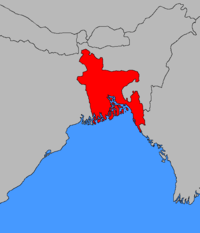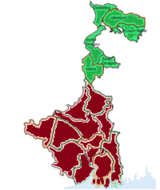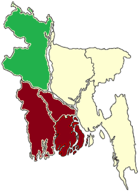Names of Bengal
Bengal is a region in South Asia, politically split between Bangladesh and India. Due to its long history and complicated political divisions, various names have been used to refer to the region and its subsections. The modern English name Bengal is an exonym derived from the Bengal Sultanate period.[1] The name is used by both Bangladesh and West Bengal in international contexts. In the Bengali language, the two Bengals each use a different term to refer to the nominally identified nation: Bānglā (বাংলা) and Baṅga (বঙ্গ)
| Part of a series on |
| Bengalis |
|---|
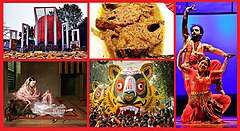 |
|
Bengali homeland |
|
Bengali culture
|
|
Bengali symbols |
Terminology in detail
- Geography:
- Bengal is a region in Asia located in the eastern part of the Indian subcontinent at the apex of the Bay of Bengal. Geographically it is part of the Ganges-Brahmaputra delta system, the largest river delta system in the world. The region borders the Himalayan states to its north and in the east borders Northeast India and the country of Burma.
- Bangla (Bengali: বাংলা) may be a transliteration of either Bengal (a geographical and ethno-linguistic region in South Asia) or Bengali (an adjective referring to something of, from, or related to Bengal). It can also refer to the endonym of the region in the Bengali language or the native name of the region.
- Banga (Bengali: বঙ্গ) is a transliteration of the Bengali name of the region of Bengal as a geographical and ethno-linguistic region in South Asia.
- Language:
- Bangladesh (Bengali: বাংলাদেশ; lit. Bengali Country) was a popular term for the region as a unified country during the Bengali Renaissance (c. 1820–1920), and was used in Bengali patriotic songs and poems like "Namo Namo Namo Bangladesh Momo" (1932) by Kazi Nazrul Islam, who later became the national poet of Bangladesh.[2] In his patriotic song Aaji Bangladesher Hridoy (1905), the poet Rabindranath Tagore used the word Bangladesh to refer to his motherland.[3][4] Alternatives to the name Bangladesh are:
- Bangadesh (Bengali: বঙ্গদেশ; lit. Bengali Country)[5]
- Bangabhumi or Banglabhumi (Bengali: বঙ্গভূমি/ বাংলাভূমি; lit. Bengali Land)[5]
- Bangarajya or Banglarajya (Bengali: বঙ্গরাজ্য/ বাংলারাজ্য; lit. Bengali Realm)[5]
- Bangarashtra or Banglarashtra (Bengali: বঙ্গরাষ্ট্র/ বাংলারাষ্ট্র; lit. Bengali State)
- Bangladesh (Bengali: বাংলাদেশ; lit. Bengali Country) was a popular term for the region as a unified country during the Bengali Renaissance (c. 1820–1920), and was used in Bengali patriotic songs and poems like "Namo Namo Namo Bangladesh Momo" (1932) by Kazi Nazrul Islam, who later became the national poet of Bangladesh.[2] In his patriotic song Aaji Bangladesher Hridoy (1905), the poet Rabindranath Tagore used the word Bangladesh to refer to his motherland.[3][4] Alternatives to the name Bangladesh are:
- Politics:
- East Bengal – The 1947 Partition of Bengal divided the British Indian province of Bengal as part of the formal Partition of India. East Bengal (now Bangladesh), which was predominantly Muslim, became a province of Pakistan. In 1955, East Bengal became the new province of East Pakistan. In 1971, East Pakistan declared Independence during the Liberation War of Bangladesh and the new nation of Bangladesh was formed.

- West Bengal – The Partition of Bengal also created West Bengal, a predominantly Hindu province of India. In 2011, the Government of West Bengal proposed a change in the official name of the state to Paschimbongo (Bengali: পশ্চিমবঙ্গ Pôshchimbônggô).[6][7] This is the native name of the state, literally meaning "West Bengal" in the Bengali language. In 2016, West Bengal Legislative Assembly passed a resolution to change the name of West Bengal to Bengal in English, Bangla in Bengali and Bangal in Hindi. Despite the Trinamool Congress government's efforts to forge a consensus, the Congress, the Left Front, and the Bharatiya Janata Party opposed the resolution and it awaits the consent of the Indian Parliament for approval.[8]
- Bangabhumi or Bir Banga – A separatist movement to create a Hindu country in southwestern Bangladesh, envisioned by Banga Sena.
- Greater Bangladesh – A political theory circulated by a number of politicians, intellectuals and writers that the People's Republic of Bangladesh has aspirations to unite Bengali-speaking regions into a greater historical Bengal. According to the theory this would include the Indian states of West Bengal, Nagaland, Manipur, Meghalaya, Sikkim, Arunachal Pradesh, Tripura, Assam, Andaman Islands, and the Rakhine State (formerly Arakan/Rohang) in Myanmar (formerly Burma) as part of its own territory with democratic governance.[9]
- United Bengal – A proposal that was put forward by Bengali political leaders Huseyn Shaheed Suhrawardy and Sarat Chandra Bose to found a united and independent nation-state of Bengal.[10][11] The proposal was floated as an alternative to the Partition of Bengal on communal lines.
- East Bengal – The 1947 Partition of Bengal divided the British Indian province of Bengal as part of the formal Partition of India. East Bengal (now Bangladesh), which was predominantly Muslim, became a province of Pakistan. In 1955, East Bengal became the new province of East Pakistan. In 1971, East Pakistan declared Independence during the Liberation War of Bangladesh and the new nation of Bangladesh was formed.
Geographical distinctions
East Bengal
East Bengal (Bengali: পূর্ববঙ্গ Purbô Bangla) was the name used during two different periods in the 20th century for a territory that roughly corresponded to the modern state of Bangladesh. Both instances involved a violent partition of Bengal which made one half East Bengal or Bangladesh.
Historically, it referred to the fertile Bhati region of the Bengal delta, which corresponds to the modern-day Dhaka Division.
North Bengal
North Bengal (Bengali: উত্তরবঙ্গ) is a term used for the north-western part of Bangladesh and northern part of West Bengal. The Bangladesh part includes the Rajshahi Division and Rangpur Division. Generally, it is the area lying west of Jamuna River and north of Padma River and includes the Barind Tract. The West Bengal part denotes the Jalpaiguri Division (Alipurduar, Cooch Behar, Darjeeling, Jalpaiguri, North Dinajpur, South Dinajpur and Malda). The Bihar parts include the Kishanganj district. It also includes parts of Darjeeling Hills. Traditionally, the Hooghly River divides West Bengal into South and North Bengal, divided again into Terai and Dooars regions.
South Bengal
South Bengal (Bengali: দক্ষিণবঙ্গ) is a term used for the southwestern part of Bangladesh and the southern part of West Bengal. The Bangladesh part includes the Khulna, Faridpur, and Barisal Divisions. The Bay of Bengal is located at the end of the southern part of Bangladesh. The West Bengal part includes 12 districts in the southern part of West Bengal; Kolkata, Howrah, Hooghly, Burdwan, East Midnapur, West Midnapur, Purulia, Bankura, Birbhum, Nadia, South 24 Parganas and North 24 Parganas.
West Bengal
West Bengal (Bengali: পশ্চিমবঙ্গ) comprises roughly one-third of the ethno-linguistic region of Bengal. When India gained independence in 1947, Bengal was partitioned along religious lines. The western part went to the Dominion of India (and was named West Bengal).
Hilly Bengal
Hilly Bengal (Bengali: পার্বত্যবঙ্গ) is a term used for the southeastern parts of Bangladesh and parts of northern Myanmar. The Bangladesh part consists of Rangamati, Khagrachari and Bandarban, while the Myanmar part consists of 14 districts in the Northern part of Rakhine (Arakan/Rohang): Maungdaw, Buthidaung, Kyaukpyu, Ponnagyan, Rathedaung, Sittwe, Pauktaw, Mrauk-U, Minbya, Myabon, Ann, Kyaukpyu, Rambree and Munaung.
Historical names
Historical names for Bengal include (in chronological order):
- Bonga – an Austric word for Sun god[12]
- Bang – a Bronze Age proto-Dravidian tribe[13]
- Vanga – a seafaring state located in the eastern part of the Indian Subcontinent comprising today's politically divided Bengal region (West Bengal, India and Bangladesh)also mentioned in Sanskrit text Mahabharata.
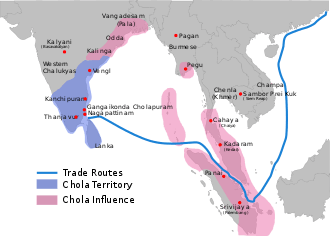 India in BC 300, showing the Chola (blue), Vangadesam (adjoining pink) and Kalinga Kingdoms
India in BC 300, showing the Chola (blue), Vangadesam (adjoining pink) and Kalinga Kingdoms - Vangaladesa – a term found in South Indian records in the 11th century.[14][15][16]
- Gauda or Gāuro Vanga (Bengali: গৌড় রাজ্যGāur Rājya ) – a Kingdom located in Bengal in ancient and medieval times.[17][18] The Pala emperors were referred to as Vangapati (Lord of Vanga) and Gaudesvara (Lord of Gauda). Sena kings also called themselves Gaudesvara. From then Gauda and Vanga seem to be interchangeable names for the whole of Bengal.[17]
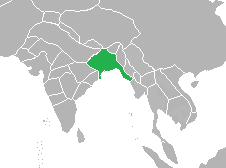 The Bengal Sultanate in 1500, during the reign of Sultan Alauddin Hussain Shah
The Bengal Sultanate in 1500, during the reign of Sultan Alauddin Hussain Shah - Bangala or Shahi Bangala – a sovereign state that encompassed present-day Bangladesh, the Indian state of West Bengal and the Myanmar state of Rakhine between the 14th and 16th centuries. It was a regional power and a melting pot of Muslims, Hindus and Buddhists, located at the crossroads of modern South Asia and Southeast Asia. During the Bengal Sultanate[19][20] Shamsuddin Ilyas Shah proclaimed himself the first Shah of Bangala in 1342.[19] Bangla became the most-common name for the region during the Islamic period.
- Bengal Subah or Mughal Bengal – a state of the Mughal Empire encompassing modern Bangladesh and the Indian states of West Bengal, Bihar and Orissa between the 16th and 18th centuries. It was established following the dissolution of the Bengal Sultanate. The Mughals played an important role in developing modern Bengali culture and society. By the 18th century, Mughal Bengal had emerged as a quasi-independent state.
- Bengala – the Portuguese referred to the Bengal as Bengala in the 16th century.[1]
- Bengalen or Dutch Bengal – a directorate of the Dutch East India Company in Bengal between 1610 and the company's liquidation in 1800.
- Bengal Presidency – the largest colonial subdivision (presidency) of British India, with its seat in Calcutta, the capital of British-held territories in South Asia until 1911. At its territorial peak in the 19th century, the presidency extended from the present-day Khyber Pakhtunkhwa province of Pakistan in the west to Burma, Singapore and Penang in the east. The Governor of Bengal was concurrently the Viceroy of India for many years. Most of the presidency's territories were eventually incorporated into other British Indian provinces and crown colonies.
- In 1905, the Presidency was partitioned into:
- British India was reorganized in 1912 and the presidency was reunited into a single Bengali-speaking province. The 1947 Partition of British India resulted in Bengal's division on religious grounds, between:
- West Bengal
- East Bengal, renamed East Pakistan in 1955
- Bangladesh – East Bengal, which became a province of Pakistan according to the provisions set forth in the Mountbatten Plan, later became the independent country of Bangladesh after the 1971 Bangladesh Liberation War.
Adjectives
- Bangla – the contents and attributes of the Bengali language or the country of Bangladesh.
- Bengali – the contents and attributes of Bengal.
- Bangiya (Bengali: বঙ্গীয়) – an adjectival prefix referring to Bengal particularly in the field of literature, e.g. Bangiya Sahitya Parishad, Bangiya Gramin Vikash Bank and Bangiya Janata Dal. Can be synonymous with Bengali.
- Bengalese – something of, from, or related to Bengal.
- Bangalee (Bengali: বাঙালি/বাঙ্গালী) – until 1978 the Constitution of Bangladesh referred all citizens of Bangladesh as Bangalees, an archaic spelling for Bengali.
- Bangladeshi (Bengali: বাংলাদেশি) – from 1978 this was a widely used term to refer to the citizens of Bangladesh.
- Bangal (Bengali: বাঙাল; Hindustani: बंगाल, بنگال) – used informally in India to refer to Bangladeshis. Bangal is also the Hindustani word for Bengal. In West Bengal, the term is widely used among upper-class subgroups to differentiate families from Bangladesh.
- Bangabasi (Bengali: বঙ্গবাসী) – peoples of Bengal.
- Bangadesiya (Bengali: বঙ্গদেশীয়) – something of, from, or related to Bengal or Bengalis.
Other names
- Bengali: গঙ্গাহৃদ/ গঙ্গাঋদ্ধি/ গঙ্গারাষ্ট্র; Gangarid / Gangaridai / Ganga Rashtra – meaning Heart of Ganges / Wealth of Ganges / Nation on the River Ganges[21]
- Bengali: গৌড় রাজ্য; Gauṛa rajya — Gauda Kingdom; meaning radiant kingdom (from Sanskrit गौड़ gauṛa "white, radiant, fair, golden", rājya, राज्य "kingdom, state"). Bengal is described in ancient Sanskrit texts as 'Gaud-Desh'.
- Arabic: رحمة; Ruhmi — meaning Land of Mercy[22][23]
- Chinese: (wiktionary: 孟加拉); (wiktionary: Mèngjiālā)
Sobriquets for Bengal
In traditional Bengali culture, as well as in the Bengali Media, the land of Bengal has assumed a number of sobriquets over the centuries, including:
- Sonar Bangla (Bengali: সোনার বাংলা); Golden Bengal
- Rūpasī Bangla (Bengali: রূপসী বাংলা); Beautiful Bengal
- Shayamal Bangla (Bengali: শ্যামল বাংলা); Green Bengal
- Epar Bangla (Bengali: এপার বাংলা); Bengal Here, used by Bengalis for their Native Bengal.
- Opar Bangla (Bengali: ওপার বাংলা); Bengal There, used by Bengalis for other part of Bengal.
- Bharatiya Bangla (Bengali: ভারতীয় বাংলা); Indian Bengal, used by Bangladeshi media for Indian state of West Bengal.
- Padmapar (Bengali: পদ্মাপাড়); Bank of River Padma, used by Indian Bengali media for Republic Bangladesh.
- Nadimatrik Desh (Bengali: নদীমাতৃক দেশ); Riverine country or the Country of the River, used for Bangladesh.
- Hazar Nodir Desh (Bengali: হাজার নদীর দেশ); the Country of the Thousand Rivers, used for Bengal.
References
- Sircar, D. C. (1990). Studies in the Geography of Ancient and Medieval India. Motilal Banarsidass. p. 135. ISBN 9788120806900.
- https://www.google.de/webhp?sourceid=chrome-instant&ion=1&espv=2&ie=UTF-8#q=nomo+nomo+nomo+bangladesh+momo&start=0
- "Notation of song aaji bangladesher hridoy". Archived from the original on 4 September 2015. Retrieved 10 September 2015.
- http://timesofindia.indiatimes.com/city/kolkata/How-is-Bangladesh-reacting-to-West-Bengals-name-change-proposal/articleshow/53558947.cms
- বঙ্গদেশ (in Bengali), 1908
- Chatterjee, Saurav (4 September 2011). "Poschim Bongo! | Promote Bangla". Promotebangla.blogspot.in. Retrieved 6 November 2015.
- "West Bengal may be renamed PaschimBanga". The Hindu. Chennai, India. 19 August 2011. Retrieved 7 February 2012.
- "West Bengal Assembly passes resolution for State's name change". The Hindu. The Hindu. 30 August 2016. Retrieved 1 September 2016.
- Venkata Siddharthacharry, Jambudwipa, a blueprint for a South Asian community, page 256, Radiant Publishers, 1985, ISBN 81-7027-088-X
- Christophe Jaffrelot (2004). A History of Pakistan and Its Origins. Anthem Press. p. 42. ISBN 9781843311492.
- "Huseyn Shaheed Suhrawardy : His Life". thedailynewnation.com. Retrieved 11 January 2015.
- SenGupta, Amitabh (2012). Scroll Paintings of Bengal: Art in the Village. AuthorHouse UK. p. 14. ISBN 978-1-4678-9663-4.
- "Bangladesh: early history, 1000 B.C.–A.D. 1202". Bangladesh: A country study. Washington, D.C.: Library of Congress. September 1988. Retrieved 1 December 2014.
Historians believe that Bengal, the area comprising present-day Bangladesh and the Indian state of West Bengal, was settled in about 1000 B.C. by Dravidian-speaking peoples who were later known as the Bang. Their homeland bore various titles that reflected earlier tribal names, such as Vanga, Banga, Bangala, Bangal, and Bengal.
- Keay, John (2000). India: A History. Atlantic Monthly Press. p. 220. ISBN 978-0-87113-800-2.
In C1020 ... launched Rajendra's great northern escapade ... peoples he defeated have been tentatively identified ... 'Vangala-desa where the rain water never stopped' sounds like a fair description of Bengal in the monsoon.
- Allan, John Andrew; Haig, T. Wolseley; Dodwell, H. H. (1934). Dodwell, H. H. (ed.). The Cambridge Shorter History of India. Cambridge University Press. p. 113.
- Sen, Sailendra Nath (1999) [First published 1988]. Ancient Indian History and Civilization. New Age International. p. 281. ISBN 978-81-224-1198-0.
- Majumdar, Dr. R.C., History of Ancient Bengal, first published 1971, reprint 2005, pp. 5–6, Tulshi Prakashani, Kolkata, ISBN 81-89118-01-3.
- Ghosh, Suchandra (2012). "Gauda, Janapada". In Islam, Sirajul; Jamal, Ahmed A. (eds.). Banglapedia: National Encyclopedia of Bangladesh (Second ed.). Asiatic Society of Bangladesh.
- Ahmed, Salahuddin (2004). Bangladesh: Past and Present. APH Publishing. pp. 23–. ISBN 978-81-7648-469-5.
- "But the most important development of this period was that the country for the first time received a name, ie Bangalah." http://en.banglapedia.org/index.php?title=Islam,_Bengal
- http://www.thedailystar.net/tags/ganga-rashtra
- Dasgupta, Biplab (2005). European Trade and Colonial Conquest. ISBN 9781843310297.
- Suhrawardi, Ghulam M. (6 November 2015). Bangladesh Maritime History. ISBN 9781460272787.
